
Modelling biological N fixation and grass-legume dynamics with process-based biogeochemical models of varying complexity
Abstract
Grasslands comprised of grass-legume mixtures could become a substitute for nitrogen fertiliser through biological nitrogen fixation (BNF) which in turn can reduce nitrous oxide emissions directly from soils without negative impacts on productivity. Models can test how legumes can be used to meet environmental and production goals, but many models used to simulate greenhouse gas (GHG) emissions from grasslands have either a poor representation of grass-legume mixtures and BNF, or poor validation of these features. Our objective is to examine how such systems are currently represented in two process-based biogeochemical models, APSIM and DayCent, when compared against an experimental dataset with different grass-legume mixtures at three nitrogen (N) fertiliser rates. Here, we propose a novel approach for coupling DayCent, a single species model to APSIM, a multi-species model, to increase the capability of DayCent when representing a range of grass-legume fractions. While dependent on specific assumptions, both models can capture the key aspects of the grass-legume growth, including biomass production and BNF and to correctly simulate the interactions between changing legume and grass fractions, particularly mixtures with a high clover fraction. Our work suggests that single species models should not be used for grass-legume mixtures beyond about 30% legume content, unless using a similar approach to that adopted here.
Citation
Fitton, N., Bindi, M., Brilli, L., Cichota, R., Dibari , C., Fuchs, K., Huguenin-Elie, O., Klumpp, K., Lieffering, M., Lüscher, A., Martin, R., McAuliffe, R., Merbold, L., Newton, P., Rees, M.R., Smith, P., Topp, F.E.C. and Snow, V. 2019. Modelling biological N fixation and grass-legume dynamics with process-based biogeochemical models of varying complexity. European Journal of Agronomy 106: 58-66.









